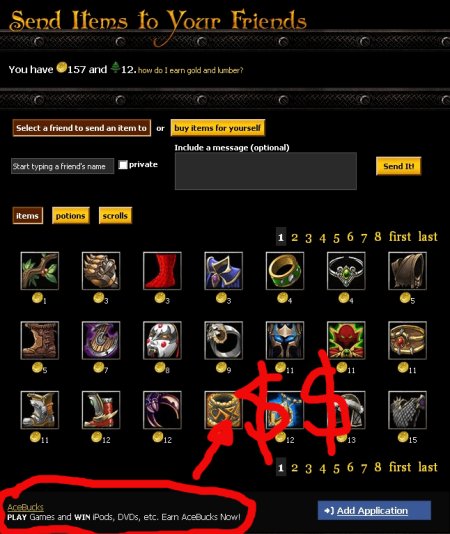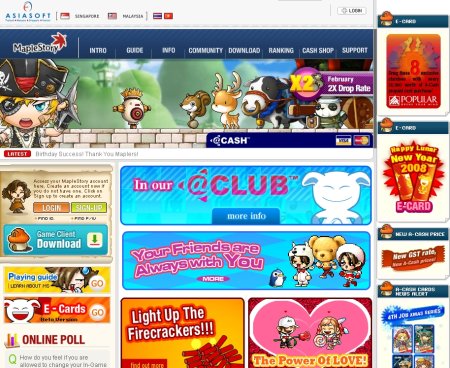A Guide To Monetizing Social Networks and MMPOGs
Social marketing can be used to not only market and promote your own products, but you can use it to effectively convert traffic (human visitors) into cash.
Following the post on the launch of Jason “Chickenhole” Bailey’s $uperRewards Facebook monetization service, I have been hearing that a lack of programming skills (PHP especially) seems to be the biggest stumbling block.
It’s actually the least of the issues you will face, because you can easily outsource the programming and API work to a developer in an Eastern European country or to India.
The biggest challenges you will face are:
- Create something that is useful for your visitors AND profitable for yourself
- How to stand out from the crowd
I’m finding that social network applications tend to fall into 2 categories:
- Monetization isn’t planned into the application and tends to be loosely added on
Take a look at this Facebook application – Defense of the Ancients –

There are banners for the AceBucks monetization application at the top and the bottom of the page.
In these instances, it’s very much “interruptive” monetization – like having ads in a TV program.
If you have a Tivo, you can wipe them out.
Similarly, with prolonged exposure to such ad placements outside of the prime real estate (the gameplay area), visitors will develop “banner blindness” after the first or second day, with the result that clickthrough rates plunge below 1% in many cases.
This is not specific to this specific application, but probably affects about 80% of such applications out there.
- Pure monetization applications
On the other hand, you have applications which are solely created to monetize. It just looks like a thinly disguised zip/email submit form. The application’s only sole reason to exist seems to collect your personal information or have you buy something.
There’s little or no content, and in my eyes, they’re the Facebook equivalent of “Made For Adsense” sites.
You might install them because they tend to be in shiny colors, but then they’re removed after the brief thrill wears off.
–
So does that mean “trying to earn an income off a social network is pointless” or is too hard or that the market is saturated, or that Facebook is going to clamp down on all money making attempts?
I don’t think so. Here’s why.
If you create value, you will be sticking around for a long time.
Value is something which adds to the user’s social experience – you might give them some entertainment, some useful information, a tip, a coupon code for something they had been planning to buy, a joke to lighten their day…
The definition is this: If they spent some time on your application and they get more value, compared to the time they spent on it. (eg. reading your information in 2 minutes, save them 30 minutes of trawling through Wikipedia, for example), then you’ve created a value user experience.
They’ll be likely to add your application and if you have an “add friend” capability, they’ll send it to their friends and your community will grow exponentially through the power of viral marketing.
If you build value as the foundation, the traffic and the growth will come.
–
Monetization:
So if direct, in-your-face, interruptive monetization techniques do not work, how do you monetize?
Use the AdSense “ad blending” techniques or product placement strategies you see on TV and movies as an example.
If monetization is a natural part of your application, and has been planned into your application development, it will be less likely to stick out like a sore thumb.
Let’s look at some of the stats Jason Bailey has thrown out – For the regular Facebook apps, it’s not uncommon to see clickthrough rates of less than 1% for the traditional monetization methods. But in cases of applications where the monetization has been integrated into the application, you can expect to see clickthrough rates of 75%.
What does this mean?
Planning has to be an integral part of your monetization process.
The monetization channel is built-in and becomes part of your application.
Seth Godin covers this aspect well in his books.
In a Fast Company article dating back to 1998, Seth Godin talks about Permission Marketing –
The new model, he argues, is built around permission. The challenge for marketers is to persuade consumers to volunteer attention – to “raise their hands” (one of Godin’s favorite phrases) – to agree to learn more about a company and its products. “Permission marketing turns strangers into friends and friends into loyal customers,” he says. “It’s not just about entertainment – it’s about education.”
And if you’re hearing some echoes of free iPods and free Xbox360s as you read this next paragraph, you’re not alone…
You can use lots of techniques to make it worthwhile for people to give you permission to talk to them. We use games because they work. Sweepstakes have been around for 700 years. Game shows were among the first programs on radio and television. Back in 1990, Prodigy asked us to create a game for it. The game’s first run ended late last year, and we’ve started it up again. It’s called Guts. Players get seven trivia questions a week. Each question is worth more points than the one before, and each is harder than the one before. You can stop at any time and keep your current score, and then come back the next week for another round. But if you miss one question, you not only lose the points from that week – you lose all your points for the whole game. So it takes guts to stay in. So far, more than 3 million people have played Guts. It’s the most popular online game in history.
People love games. They’re fun, exciting, engaging. We not only entertain people but also educate them – and we get paid for it! We create promotions in which the game itself involves information about products. People search for ads and read them because they have to find missing pieces of information to get the prizes they want. When’s the last time you searched for a TV commercial?
–
As an example of a social network that has it’s own economy (which translates into a real world dollars-and-sense economy) take a look at Second Life:

The Linden (Second Life’s unit of currency) can be converted into real world currency. And the economy has it’s instruction manuals:

With titles focused on how to get rich in second life, how to do “everything” in second life.
These “make money online” books are available at Amazon, for real dollars, of course…
So it’s a matter of time before the flood of make money on Facebook books appear.
–
If you are still looking for examples, take a look at free MMPOG Maplestory:

The free MMPOG which is a sideways third-person RPG shooter is free to play, but if you want upgrades, you need to pay for them.
So if you’re paying real world money for virtual items,
Real $$$ -> Virtual weapons/armor.
Wouldn’t the virtual social economy that’s building up on Facebook be something that can be converted into real world currency too?
Virtual rewards points -> Real world prizes and real world cash
For more information, check out:
–> $uper Rewards Facebook Monetization Service
Related Posts
5 comments on A Guide To Monetizing Social Networks and MMPOGs
3 Pingbacks & Trackbacks on A Guide To Monetizing Social Networks and MMPOGs
-
[…] A Guide to Monetizing Social Networks and MMPGOs Problems are that either monetization isn’t planned into the application, or that it’s pure monetization. Need a valuable user experience and permission-based marketing. Source: WhoIsAndrewWee.com: Blogging, Affiliate Marketing, Social Traffic Generation […]
-
[…] A Guide to Monetizing Social Networks and MMPGOs Problems are that either monetization isn’t planned into the application, or that it’s pure monetization. Need a valuable user experience and permission-based marketing. Source: WhoIsAndrewWee.com: Blogging, Affiliate Marketing, Social Traffic Generation […]
-
[…] A Guide to Monetizing Social Networks and MMPGOs Problems are that either monetization isn’t planned into the application, or that it’s pure monetization. Need a valuable user experience and permission-based marketing. Source: WhoIsAndrewWee.com: Blogging, Affiliate Marketing, Social Traffic Generation […]






Aurelius Tjin
February 6, 2008 at 2:16 pm (16 years ago)This is an information that is obviously of great value. I totally
agree with your statements.Thanks for sharing it!
click this link
July 28, 2020 at 8:51 am (4 years ago)Wood household furniture has one thing quite
all natural about it. There is this sense of heat, of
attribute and also of sophistication that may be be discovered in wood furnishings.
Wood is born from the planet. It feeds the
fire, breaks down in to blows and ashes away.
It is actually really near to the human existence in the world.
Might be that is why it sounds so much with our company.
May be that is why you still get that hot emotion when you contact
a rich mahogany workdesk.